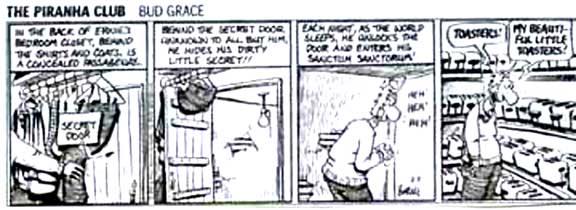
The Toaster Page

Join Us on Facebook
Just in case you have a special request, here are some navigational tools
- A Celebration of Toast
- Flappers (Early Electric/Manual Toasters)
- The Steelcraft "Coathanger"
- The Sunbeam Model 4
- The Sunbeam "Toast Witch"
- The Marion Fliptop
- The Knapp-Monarch Flapper
- The Manning-Bowman Flapper
- The Bersted "Victorian"
- The Hotpoint (GE Model D-12) "Wire Fence"
- The Universal "Sweetheart"
- The Chicago Electric "Handy Hot"
- The Hotpoint "Gazelle"
- The Universal "Model E-7732"
- The Edicraft "Clamshell" Toaster
- The Armstrong "Perc-O-Toaster" Combination
- Toastmaster (Walters-Gentner) Toasters
- Toastmaster 1B3 (Harry Truman's Toaster)
- Toastmaster 1B5
- Toastmaster 1B14
- Sunbeam Toasters
- Sunbeam T1C and T1D
- Sunbeam T-9 The Half-Round Wonder
- Service Manual for the T-9 Free Download
- Sunbeam T-20 The Bagel is Recognized
- General Electric Toasters
- Another Truman Toaster
- The Toast-O-Lator
- Toaster Pictures From Our Readers!
- Toasters in the News!
- Replacement Cords for Toasters and Other Appliances
- The Toaster Collectors Association, a membership association of people who collect, research, document, conserve and restore electric and nonelectric toast-making devices.
In addition to the Romance of Toasters, we have a Calendar of Swing Dancing in DC, a Directory of Vintage Clothing Stores and a Guide to 1940s Collectibles. Thanks for tuning in! Contact Us if you want to share photographs or just make a "toast".
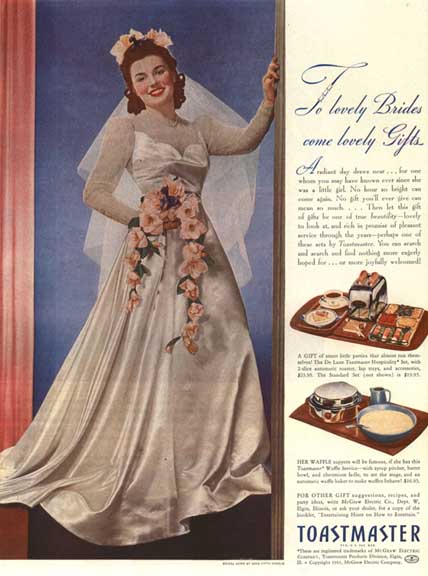
$25 in 1941 is Equivalent to $600 in 2009 -- a Pricey Gift
This page is devoted to Toast and the marvelous machines that create this delicacy. However, before we begin our celebration, we must give credit to that which makes even, honey brown toast possible --- the BREAD SLICER.
The cliche "the best thing since white bread" is used to describe many things that are in themselves superlatives. So, behold the humble commercial bread slicer: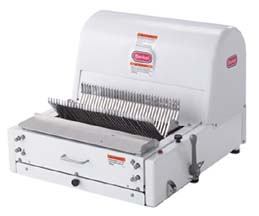
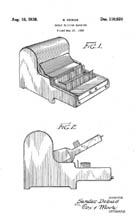
Behold - The Bread Slicer
Bread Slicer Design Patent D-110,920
Click Photo to Enlarge It
The commercial bread slicer really hasn't changed a whole lot since the 1930s -- the slicer on the left was in a 2009 catalogue.
Toast-O-Lator
Check out our complete restoration of a Toast-O-Lator. Click here
Here is a wonderful photograph from the mid 1940s showing a display of appliances at a Sears store in Chicago. Many of the toasters are described below and the coffeee makers can be found on our Coffee Paraphernalia Page.
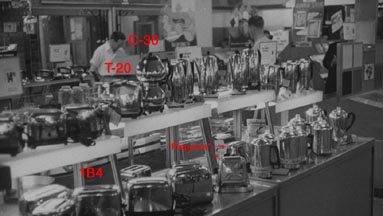
Toasters and Coffee Makers Galore at Sears, c. 1946
Click Photo to Enlarge It
Early toasters were definitely NOT automatic -- all they did was substitute electrical resistance heat for the heat from a fire or stove -- you were responsible for turning the toast and taking it out when it was done. Most of these had some sort of door or lid that had to be opened to turn the slice of bread over so that it could be toasted. It is for this reason (and the fact that they were mostly sold in the 1920s) that I call this genre the "Flappers" -- you had to be on your toes to "flap" the door open. These were made from 1915 to well into the 1940s. Here's a design for a "flapper" made in 1938:
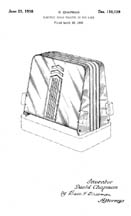
Flapper Toaster Design Patent D-110,139
David Chapman for Knapp-Monarch
Click to Enlarge
The Steelcraft "Coathanger"
This bare-boned toaster is owned by our friend "Acme Ron" in Phoenix. He comments, "... I don't think Underwriters Laboratories would approve. ..."
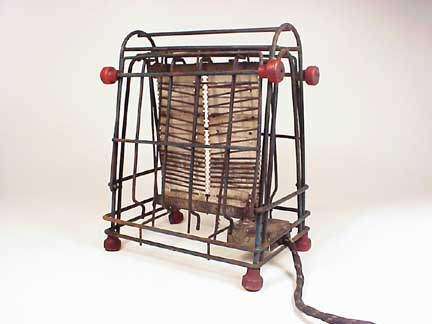
The Steelcraft "Coathanger" Toaster from the 1920s
The Sunbeam Model No. 4
This is a nice little toaster that looks like a modern sandwich grill -- the toast is prepared in a horizontal heating area.

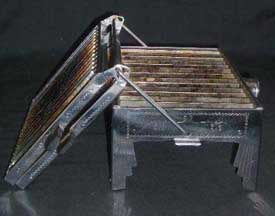

Sunbeam No. 4 Toaster from the 1920s
Mr. Ernest Sjolin gets the credit for designing the Sunbeam No.4. He was issued patent Number 1,465,007 in August of 1922 for his creative efforts.
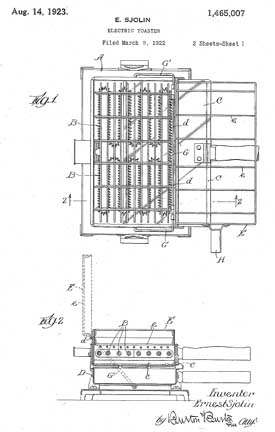
Mr. Sjolins Patent 1,465,007
Click here if you want to learn how to get Free Patent Drawings
Sunbeam"Toast Witch"
Sometime later, the Sunbeam Company came out with Model 65, known as the Toast Witch. To a large extent, it is based on Mr. Sjolin's patent, although it does allow for the making of grilled sandwiches as well as toast (hence the name). Functionality takes a back seat to the magnificent Art Deco design of this appliance. I am thrilled that our friend "Acme Ron" has shared these photos with us.
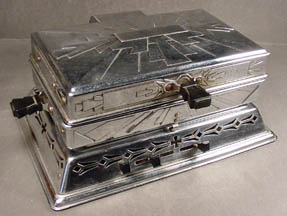
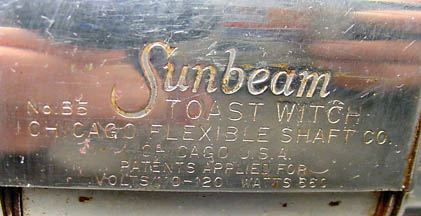
The Sunbeam Toast Witch
Click to enlarge either photo
Click here if you want to learn how to get Free Patent Drawings
You can see why these marvelous devices command high prices in auctions.
The Marion Fliptop

This early toaster was made by the RUTENBER ELECTRIC CO, of Marion, Indiana. Rutenber is also well known in the antiques world for the Marion Fliptop Toaster. They coined the slogan "Make Toast Your Breakfast Food" Anything from the Rutenber company is VERY collectible and very well made.
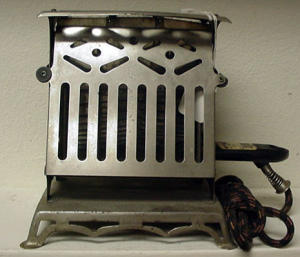
Here is a Special Website all about the Rutenber Company that will give you all the details about their wonderful history and fabulous products.
The Knapp-Monarch
This toaster begins to have the modern form -- the toast is prepared vertically and the sides of the appliance "flap" down to permit the user to rotate the bread. This one will make two slices of toast, sort of at the same time
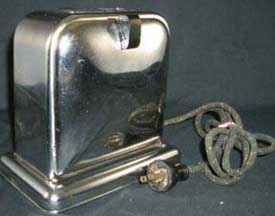
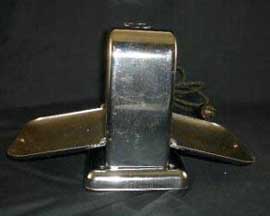
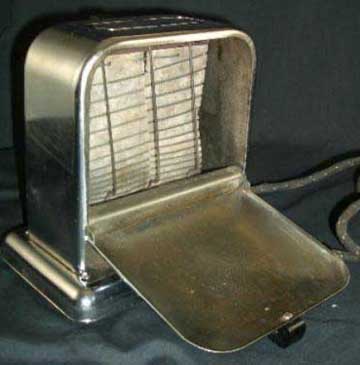
Knapp-Monarch "Flapper" from the Early 1930s
This toaster was patented by Mr. Ernest Johnson in 1930
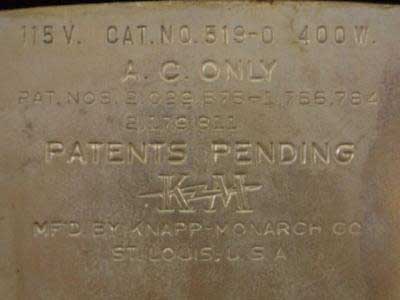
Knapp-Monarch Maker's Mark
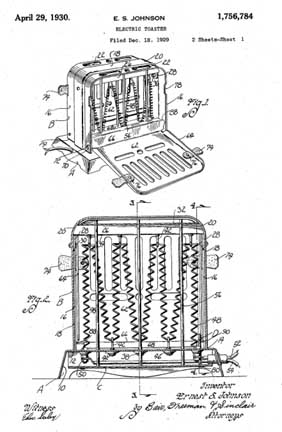
Mr. Johnson's Patent 1,756,784
Click here if you want to learn how to get Free Patent Drawings
Manning-Bowman Flapper
Here is a manual toaster made by the celebrated Manning-Bowman Company. This probably illustrates the widely cied axion, "The last days of old technology are better than the first days of new technology." This is a very nice chrome toaster that has the form of the new "pop-up" models that were quite the rage. However, it is just another variant of the "flapper"

Ad for a Manning Bowman Manual Toaster
The Victorian
At the other end of the quality scale is this four-slice version of the "flapper" that was made by the Bersted Company of Ohio. Bersted made low-cost appliances by cutting out "nonessentials" and using lower grades of materials. Their products were sold in high-volume retail outlets and are known as Drug Store toasters. They are rare because they did not last very long, hence people junked them and few are left for us to examine. This type of thing is for serious toaster collectors only. Alas, when Manning-Bowman went out of business, their designs were bought by Bersted and reissued in apallingly cheap versions. If Bersted was in the TV production business, they would be making reality shows. Nobody ever lost money underestimating American popular taste.
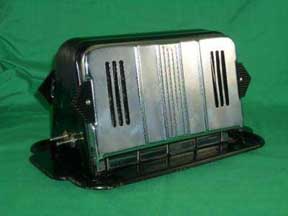
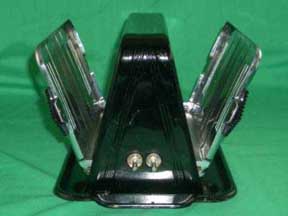

The Bersted "Victorian" (Model 66)
The Sweetheart
Possibly the most beautiful toaster from the "flapper" era is the Universal Sweetheart (Model E-9410), manufactured by Landers, Frary and Clark. These lovely photos come from our good friend "Acme Rone" Heberlee of Phoenix.
Ron has this to say:
"... This is the embossed 9410 model. the 9411 was plain. First one I have seen that has all the Bakelite intact and works. Push the button down, the cage swings halfway to insert or remove bread; let go of the button and it returns flipping the bread, or is it half toast now......my granddaughter loves to ask people 'What do you put in a toaster?' ..."
In May of 1929 George Curtiss was granted a design patent on the Universal E-9410 with its easily recognizable diamond and ear ring pattern
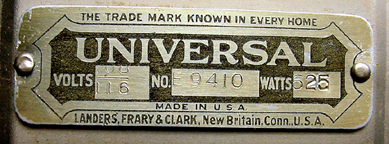
The Manufacturer's Plate



The Landers, Frary and Clark Model E-9410 Sweetheart Toaster
Curtiss "Sweetheart" Toaster Design Patent D-78,504
Click to Enlarge
Click here if you want to learn how to get Free Patent Drawings
The Chicago Electric "Handy Hot"
Here is a toaster (c. 1936) that uses Art Deco architectural styling. It was made by the Chicago Electric Company and is known as the "Handy Hot" (Model AEUB).
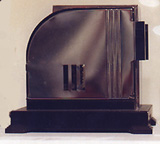

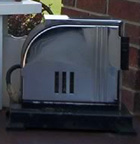
The Chicago Electric Model AEUB Handy-Hot Toaster
Click to Enlarge
This toaster was designed by James Barnes and Jean Otis Rienecke, a team that gave us the Milkshake Mixer, the fabulous AMI Juke Boxes, as well as the Toastmaster Toaster discussed below.

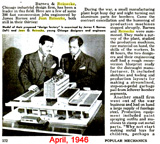
The Design Team of Barnes and Reinecke
Handy Hot Toaster Design Patent D-91,978
Click to Enlarge
Click here if you want to learn how to get Free Patent Drawings
Reinecke and Barnes had a long and successful career and brought numerous products to market, including the iconic Scotch Tape dispenser and the infamous Foot X-Ray machine.
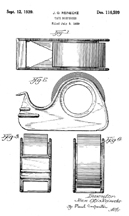
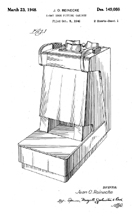
Jean Otis Reinecke
Scotch Tape Dispenser Patent No. D-116,599
The Infamous Foot X-Ray Machine, Patent D-149,088
Click to Enlarge
Click here if you want to learn how to get Patent Drawings
The GE Model D-12, "Wire Fence"
This is a very early manual toaster that seems to defy safety. Basically, it is a "Fence" of resistance wire with no covering. The user placed the bred inside the fence and watched it very carefully. I do not know how the toast was extracted from the heat, possibly with wooden tweezers. The only nod to convenience is a tilted rack that was used to store toast. There is no "power" switch. Electrocutions and third degree burns must have been frequent. This type of thing was placed on the market before there was effective consumer protection. In general, I have no use for the "nanny state" but this is ridiculous!! The wire fence toaster was patented by Frank Shailor in 1910 as an "electric heater".
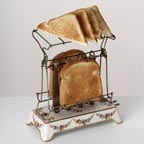
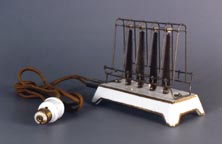

The GE Model D-12 "Wire Fence" Toaster
Frank Shailor's Wire Fence Toaster, Patent No. 950,058
Note the cord for a light socket
Click to Enlarge
Click here if you want to learn how to get Free Patent Drawings
Of note in the middle photo is the cord -- you'll note that it is designed for use in a light socket. At the time this toaster was made, most houses were only wired for lighting. (In some places, electricity was only generated at night.) Thus, many folks did not have wall outlets. It is for that reason, the cords were detachable -- you could use one with a screw-in connection if you only had a light fixture hanging from the ceiling. If you had wall outlets, you could use one with a more standard plug. Here is an extreme example of the use of "lighting plugs".
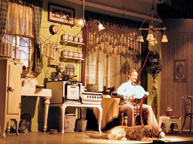
A multiplicity of light-cord connections...
Click to Enlarge
Threats to safety were NOT limited to the consumer. Here is a photograph of ladies assembling the D-12. You'll note that in the background to the right is a fan with no blade guard. This is a GE "Pancake" Fan named for its outsized motor. However, a look at the back of the fan shows that it was "hot wired". Thus, employees stood to lose fingers or be electrocuted. Annoying as it is, there is a definite need for OSHA.
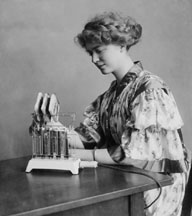
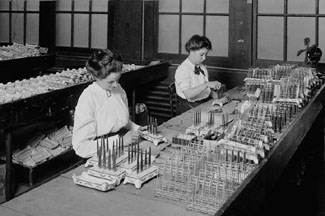
Using and Assembling the GE Model D-12 Toaster
Women were used because they had "nimble fingers"
and worked for next to nothing...
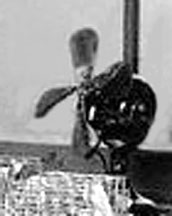
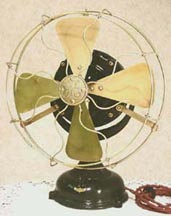
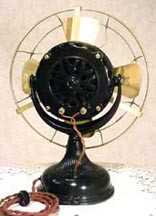
The Dangerous Fan
The workroom fan has prosaic black steel blades
Note "hot wiring to terminals on the rear
Click Here to see a video of this fan in action
Click to Enlarge
The Gazelle
This is one of the most desirable toasters. It was made by General Electric under their "Hotpoint" brand. It is probably the ultimate in manual toasters and the lovely gazelle on the front is a major Art Deco Icon. Thanks to our friend "Acme Ron" in Phoenix for sending this in.
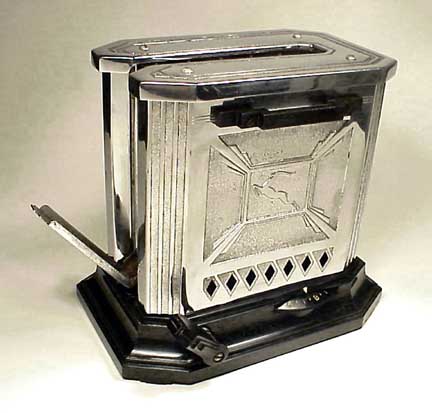
The GE Hotpoint "Gazelle" Toaster
The Universal "Lux" Model E7732
This is an unusual toaster that is just on the "cusp" of manual versus automatic operation. In this (large) toaster, a clockwork mechanism causes a "toast drawer" to flamp open when a predetermined amount of time has passed. This is basically a "flapper" with a timing mechanism. The thing had to be heavy because the flopping toast chamber might tip the thing over. These photos also come from our good friend "Acme Rone" Heberlee of Phoenix.
Ron has this to say:
"... The black lever will to open it manually, other side has the timer (missing knob) and a light/dark setting. It pops open when done. It is 11 inches tall and weighs 7 pounds! Must have cost a bundle..."
This is an Automatic toaster that is operated by a Lux timer (similar to a kitchen egg timer) For your edification, the Lux Products Corporation was originally founded in 1914 by Paul Lux as the Lux Clock Manufacturing Company. It was based in Waterbury, Connecticut and produced only clock movements at that time. In the years that followed, the company grew and began making the entire clock unit. Lux Clock produced clocks until 1941, at which time they made war related products. Clock production resumed after the war, and in 1954 a plant was established in Lebanon, Tennessee. In June 1961, the Robertshaw-Fulton Controls Company, a leading manufacturer of thermostats and controls, bought out the Lux Clock Manufacturing Company.
In July of 1932 George Anderson and Fred Juengst was granted a design patent on the Universal E-7732.

The Manufacturer's Plate
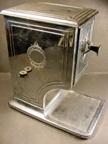



The Landers, Frary and Clark Model E-7732 Lux Toaster
Anderson and Juengst Toaster Design Patent D-87,297
Click to Enlarge
Click here if you want to learn how to get Free Patent Drawings
The Edicraft Clamshell Toaster
In 1887,Thomas Edison built a research laboratory to be devoted to the "rapid and cheap development of inventions." Eventually, about 200 scientists, engineers, and technicians were employed there to invent to order, “useful things that every man woman and child wants… at a price they can afford to pay.” The "Edicraft" line came close to fitting this paradigm -- it was developed in the late 1920s when electric appliances were a growing industry that generated high profits. The "Edicraft" line included a clamshell type toaster [below], a sandwich grill, a waffle iron, a combination grill/waffle iron and a coffee urn/water heater (the “Siphonator”.) The entire line was of high quality but were expensive, on the order of $25 per unit -- equivalent to $800 in 2011! The Edison Company stopped production of appliances in 1934.
Edison died in 1931, at age 84, but his company, Thomas A. Edison Inc., remained in business until 1957 when it became a subsidiary of McGraw-Electric.
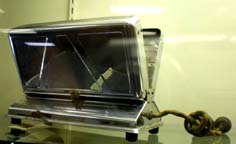
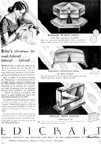
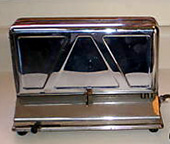



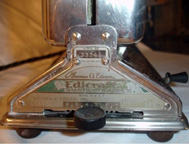
The Edicraft Clamshell Toaster
Patent 1,683,211
Click to Enlarge
Click Here to download a complete copy of this patent
The Armstrong "Perc-O-Toaster"
This is a very interesting "hybrid" appliance that was manufactured during the 1920s by the Armstrong Electric Company of Huntignton, West Virginia. The unusual design has the toast elements in a drawer with heating elements on the top and bottom so that no "turning" is necessary. (It makes one slice at a time.) A separate mound-shaped compnent contains heating coils and fits within the bottom of the percolator. These items are quite rare. They were very well made but were rendered obsolete by newer, cheaper multi-slice toasters. Also, the percolator process does not make the best coffee.

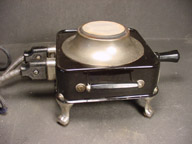
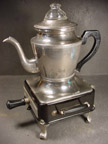

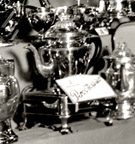
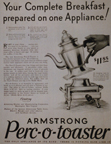


The Armstrong Perc-O-Toaster
Ad in the May 1931 Saturday Evening Post
Percolator Component Design Patent D-80,717
Toaster Component Design Patent D-78702
Click to Enlarge
Click Here to download a complete copy of the Percolator Patent
Click Here to download a complete copy of the Toaster Patent
If you are contemplating buying one of these, you should be very careful to insist on seeing the original cord and plug -- this uses a noonstandard plug arrangement that cannot be duplicated with new or period cords.

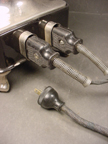
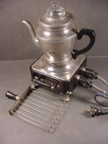
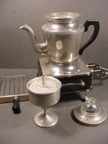
The Unusual Plug Arrangement
If you buy one, make sure that you get this!
Click to Enlarge
"Toastmaster" is a registered brand name for the Walters-Gentner Corporation. It is a clever play of words, and since Walters-Gentner got there first, they prevented Sunbeam from offering a toaster in their "...master" line (i.e the "Mixmaster","Ironmaster","shavemaster", etc, etc.
Toastmaster 1B3
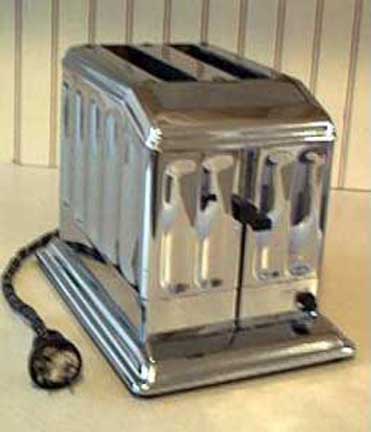
Toastmaster Model 1B3
This is the Toastmaster Model 1B3, a lovely toaster in heavy chrome. This is part of a whole class of toasters made by the Walters-Gentner Corporation using a clockwork mechanism that was patented by Murray Ireland in 1932. The toaster embodies all the classic elements that made "popup" toasting a cultural icon. Due to the size of the mechanism, these toasters were asymmetric -- there was a toasting side (i.e electrical resistance wires) and a popup side. Toast goes into the slots and a lever is depressed. This lowers the toast, switches on the heating element, and compresses the spring on the clockwork timer. Depending on the setting of a "doneness lever", the clockwork "ticks" off the fractions of a second, turning a small gear. When the gear reaches a particular point, it trips a lever and releases the toast basket. The compressed spring forces the basket upward, carrying the toast up and beyond the heating element. The sound of the release ("ka-ching") is part of the lore of popup toasting.
The Model 1B3 has an unusually quiet timing mechanism and you have to listen very closely to hear the clockwork operating.

Early Toastmaster Models are Asymmetric
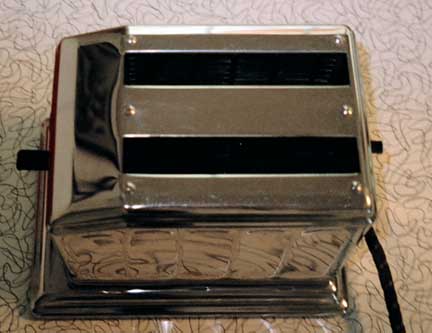
Top View Highlights the Popup Mechanism Section on the Left
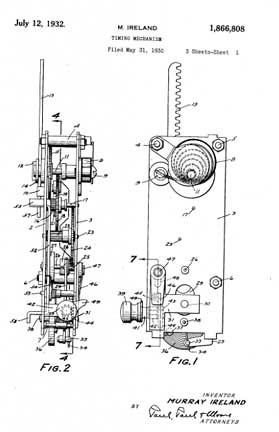
Murray Ireland's Patented Clockwork Popup Mechanism, Patent 1,866,808

"Toastmaster", the Trademark of the Walters-Gentner Corporation
On the Clockwork Side
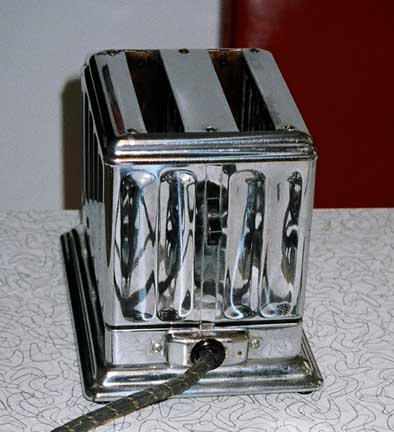
The Non-Operating Lever on the Toast Side
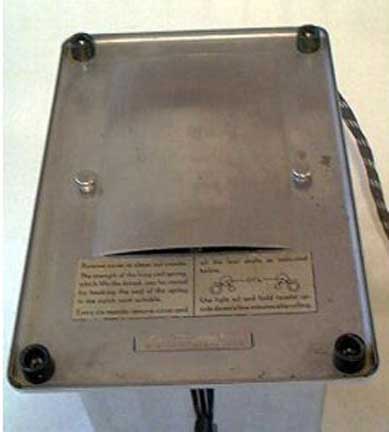
The Footplate and Crumb Tray
Walters-Gentner also made a one-slice version of this toaster. Here are some photos of that particular variant:
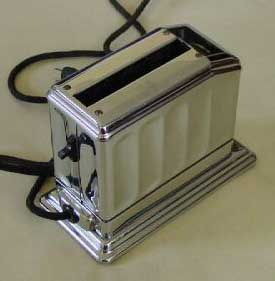
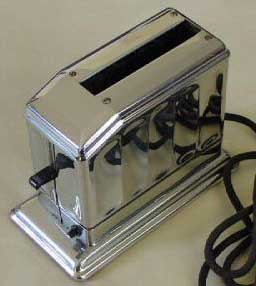
Toastmaster Model 1A3, One-Slice Model
Here are two photos from a World War II era training pamphlet that show you how to empty crumbs from a toaster. The subject was "How to Use Electrical Appliances." Many rural households were just getting electricity due to the Rural Electrification Administration (REA) and the pamphlet was intended to get folks up to speed with the rest of the country. This photo shows the Government-approved method of removing crumbs from a Model 1B3.


Removing Crumbs from the 1B3
Click Either Photo to Enlarge It
It turns out that the Model 1B3 traveled in pretty refined social circles. Apparently, the 1B3 was good enough to attract the attention of none other than Harry S Truman. Here is a photo of Harry toasting some whole wheat bread, possibly fantasizing that he was putting General MacArthur into the thing. Harry had great taste and style -- note that he also had a Fiesta pitcher and that he has used the very fashionable Half-Windsor knot for his tie. His wife Bess looks on, probably thinking: "Well he can't do anything about the steel strike or Korea, maybe he can make toast..."
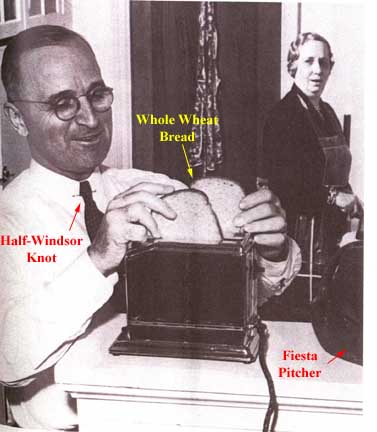
Harry Truman Makes Toast with his Toastmaster 1B3
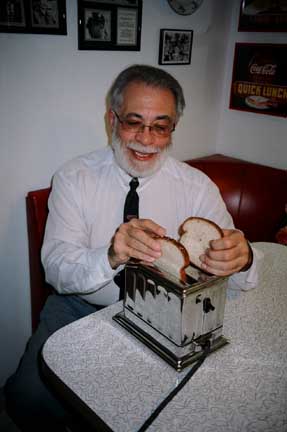
Frank Makes Toast with his Toastmaster 1B3
I Couldn't Resist Re-staging the photo. (See below for more on Harry Truman)
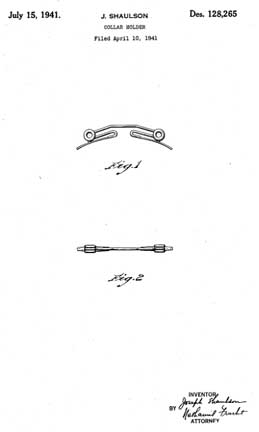
The Patent for the Collar Pin Being Worn by Both Toast-Makers
Designed by Joseph Shaulson of Providence, Rhode Island
Click here if you want to learn how to get Free Patent Drawings
Recently, I got the following note and photo from, Eric A. Murrell editor of the Toaster Collector’s Newsletter – The Saturday Evening Toast.:
"...George Waters the grandson of the founder of Waters-Genter credits this hospitality set with the success of Toastmaster throughout the 30s. He said that the appliance stores usually lined up the toasters of the various manufacturers side-by-side and when the 1B-3 was shown on the hospitality tray, space was created between it and its neighbors. This made it stand out amongst its peers and a legend was born..."
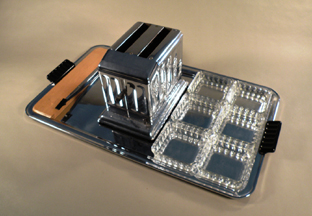
Toastmaster 1B3 Hospitality Set
Thanks, Eric
Click to Enlarge It
Toastmaster 1B5
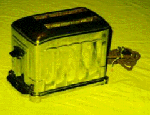
1930s "Toastmaster"
Model 1B5 two-slice automatic pop-up
This is an absolutely wonderful early example of a pop-up toaster. This little gem works perfectly and it is absolutely immaculate --- not a scratch on it! I got it in Ellicott City; if you turn it over, you will see a serial number for the toaster. This is a dead giveaway to value --- in the very early years, the number of toasters being manufactured was low, so they could actually put an individual serial number on each machine. When these were mega-mega mass-produced, serial numbers became impractical.
Here's what Toaster Central has to say about the Model 1B5:
"'Cheek to Cheek' by Irving Berlin topped the charts and '42nd Street' was running on Broadway when Toastmaster produced this stunning architectural design with that could have been a Busby Berkeley set! It has a clockwork timer that ticks with settings from light to dark. Remove the bottom cover for crumb extraction. The Model 1B5 was produced from July 1934 until June 1936 by McGraw Electric Company. "
Here's the details from the Manufacurer's plate:
Waters-Genter Div
MPLS MINN USA
Mod1B5 No. B 506634
Toastmaster 1B14
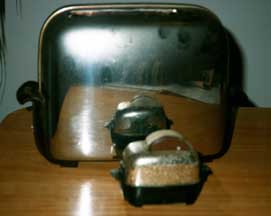
The Toastmaster Model 1B14
With Novelty Salt Shakers
Click to Enlarge
This is the toaster that set the standard for Toasters. This is the famous "Flying Toaster" of the "After Dark" screen saver that was the rage in the late 1980s. Think of a toaster and the Toastmaster comes into your mind. This is a particularly good example of the species because it is one of the very first models, made by McGraw Electric a predecessor of Sunbeam. These things were the definitive wedding gift of the 1940s and 1950s and are in good supply, although "First Editions" like this are scarce. These made a good wedding gift because they are made to last a lifetime! Appliances and marriages have declined in durability since the Toastmaster came on the scene.
The Toastmaster Model 1B14 is shown along with a novelty salt and pepper shaker that was inspired by its big brother. The white slice is salt and the whole wheat is pepper. They pop up, too...
Sunbeam T1
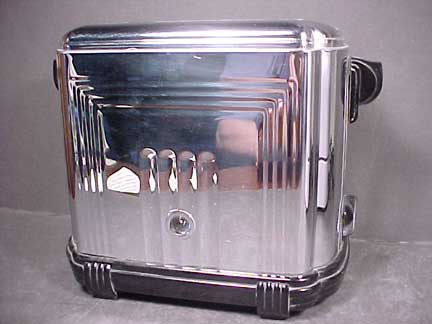
Sunbeam Model T-1 Toaster
This is the Sunbeam T-1 D made in 1936. This two-slice toaster is automatic but not pop-up. When the toast is done, the toasting panels turn off automatically. It uses a bimetal timing mechanism rather than a clockworks hence the name "Silent Automatic." The beautiful chrome body with bakelite handles sits on an ornate bakelite base. It features a faceted glass jewel set in the front that glows orange when the toaster is in operation
This photo was sent to us by Ron, who also included a photo of the T-1 in his mother's kitchen, sometime in the 1950s. Ron writes: "...They are usually listed on Ebay as not working because people think they pop-up when they don't. It was like a waffle iron, when the red light went off, you raised the toast up by hand..."

The T-1 in Ron's Mom's Kitchen
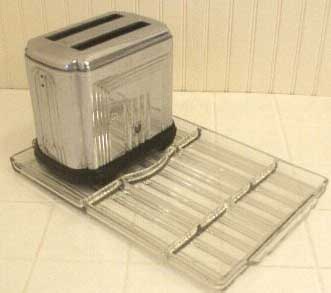
Complete T-1 Presentation Set (with the Toaster)
Our friend "40sPhil" sent us two very nice photos of his model T-1-C variants

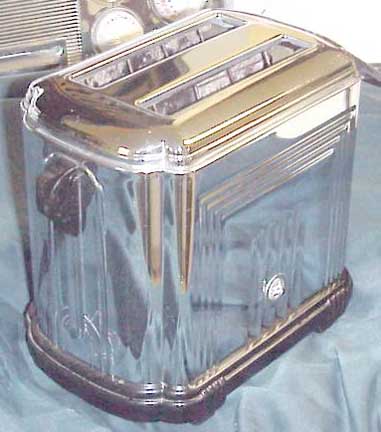
Phil's T1C Variants
The exterior of the Model T1C was designed Alfred F. Fukal of Chicago, Illinois. Mr. Fukal was an employee of the Chicago Flexible Shaft Co., the corporate parent of Sunbeam. Mr. Fukal applied for his design patent on November 19, 1935 and it was granted (as Des. 98,247) on January 21, 1936.
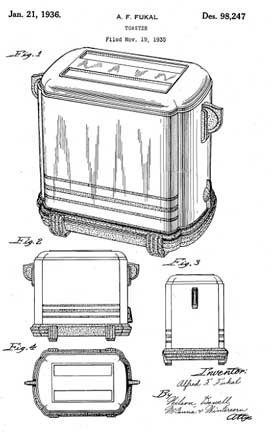
Mr. Fukal's Patent Des 98,247
Click here if you want to learn how to get Free Patent Drawings
Sunbeam Model T-9
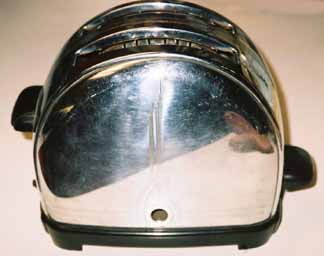
Sunbeam Model T-9 Toaster
This is the very famous Sunbeam T-9 Toaster, possibly the most popular model ever made. The lines etched on the front and back of the toaster are symbolic of the 1939 New York World's Fair. The T-9 was issued in that year and used this device to tag onto the popularity of the event.
Click Here for the results of a poll in which appliance collectors rated the T-9 as the most desired antique toaster.
The T-9 was immortalized by Norman Rockwell in his October 30, 1948 cover for The Saturday Evening Post, as shown below
The October 30, 1948 cover of The Saturday Evening Post
Click Here to read about the Douglas "Kitchen-Master" Chairs
Click Here to read about the Silex Vacuum Coffee maker
We also have this in from the fabulous 40s Phil of Marion Indiana:
"... Here's a little known 'factoid' that only the 'toaster Geeks' are aware of: Turn the Sunbeam T-9 toaster upside down and you'll see that the fabulous Art Deco logo engraved on the side is the letter 'T' with a '9' superimposed on it!..."
By golly, he's right!
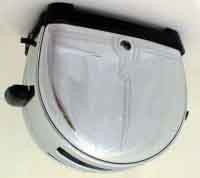
Sunbeam Model T-9 Toaster, Inverted
On the other hand, many people believe that this logo actually refers to the Trylon and Perisphere of the 1939 New York World's Fair. Here is an ad for the Sumbeam Model T-7 that has the same design on the side...
Ad for the Sunbeam T-7
Here is the ad that introduced the Model T-9, taken from the Saturday Evening Post in 1939. A gigantic T-9 is shown surrounded by a legion of housewives who marvel at its many new features. If you check out the patent diagrams below, you will certainly agree that the T-9 brought a whole new level of complexity to toaster design and manufacture.
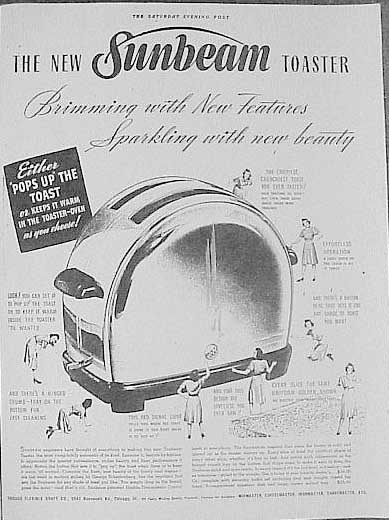
Very First Ad for the Sunbeam T-9 (Thanks to "40s Phil")
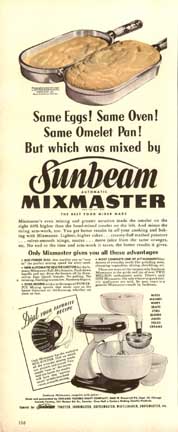
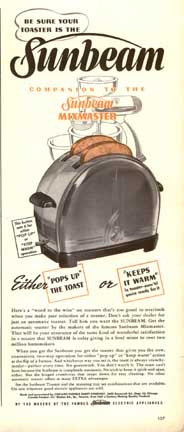
Matching Ads that Ran on facing Pages
in the October 6, 1941 issue of LIFE Magazine
read About the Mixmaster on our Kitchen Mixers Page
Here are some photos from a 1946 article in LIFE Magazine showing T-9 Toasters on the Sunbeam Assembly line. Apparently, each toaster was subjected to a "reality test" by actually toasting bread.

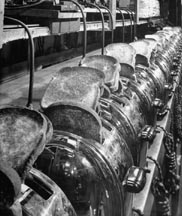
The T-9 Assembly Line at the Sunbeam Factory, c. 1946
Click Either Photo to Enlarge It
In addition to this, 40s Phil shares with us his Neon T-9. Phil writes:
I had a [T-9] with a couple of bad elements so I decided to have it converted to Neon toast. (see attachment). I forgot to specify 'Neon Orange' (which is about the same color as a glowing toaster element) for a color preference so I ended up with yellow. If you want to see a fascinating sight - plug in the T-9, push the lever down, then turn out the lights and watch the 'sunrays' and the glowing 'jewel'.
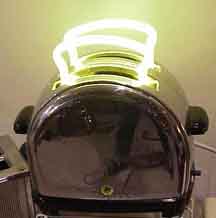
Phil's Neon Toaster
In June of 2005, I walked past a yard sale and an unusual piece of glass struck my eye: it had the famous Sunbeam "Worlds Fair" (or T-9) Logo embossed in it. It turns out that this is the Tray Liner for the fancy presentation set for the T-9, as shown by the blue arrow in this ad:
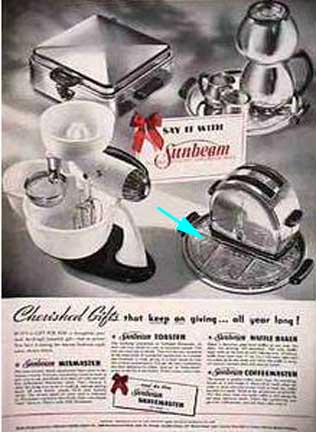
The T-9 Presentation Set (Blue Arrow)
This Was Always in Good Taste for a Wedding or Anniversary

Tray Liner for the T-9 Presentation Set
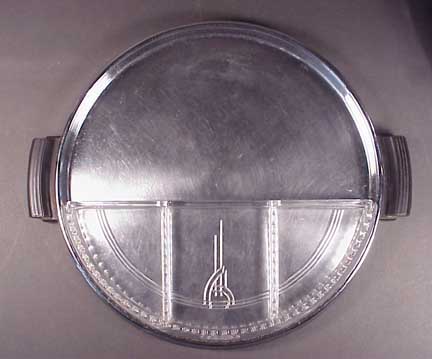
Complete Tray for the T-9 Presentation Set

Complete T-9 Presentation Set (with the Toaster)

Alternate Versions of the T-9 Tray Set
Check our Kitchen Mixer Page for a 1947 Sunbeam Price List that includes the T-9 Tray Sets
The Sunbeam T-9 was engineered by Ludvik Koci of the Chicago Flexible Shaft Corporation (the corporate parent of Sunbeam). The exterior design was patented by George Scharfenberg, a noted designer and Sunbeam employee. Koci and Scharfenberg must have worked closely together because the following patent diagrams show that the semi-circle shape of the T-9's exterior is also an essential component of the mechanical design. Because the T-9 is such an important Toaster, we are reproducing ALL the patent diagrams. These should be enormously helpful in repairing or restoring one of these beautiful objects!
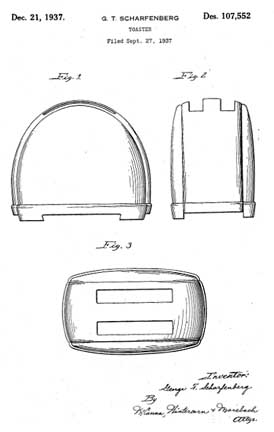
George Scharfenberg's Design Patent for the T-9

Side View, Popup Mechanism
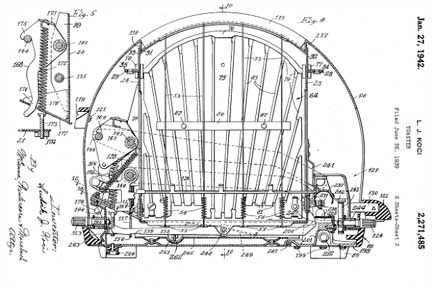
Side View Toasting Mechanism and the "Sunrays"
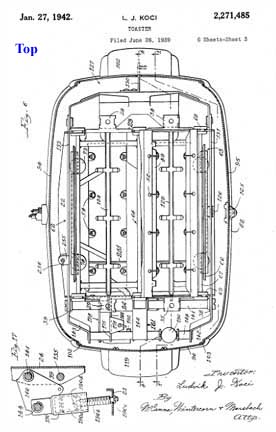
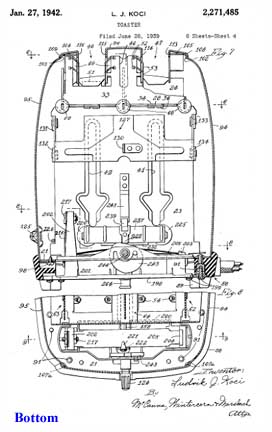
Top and Bottom Views
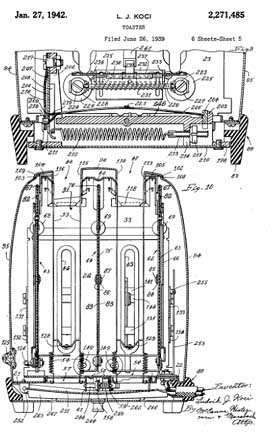
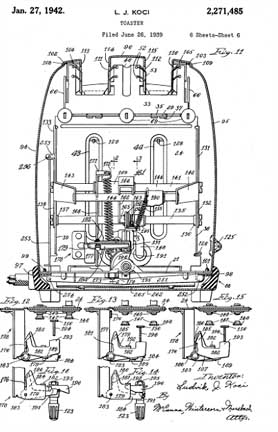
End Views
Click here if you want to learn how to get Free Patent Drawings
Of all things, the Chinese company that owns the Sunbeam name has reissued a heritage model toaster that sort-of resembles the T-9, except that it is made out of a cheesy metal that is definitely not chrome.
Sunbeam Model T-9 Service Manual
Free Download

The T-9 Service Manual, c. 1949
Click to Enlarge
Through the good graces of our reader and friend Alvin K, we have acquired a copy of the official T-9 Service Manual. We are very pleased to make this available to you at NO COST.
Enjoy this with our compliments.
Sunbeam Model T-20
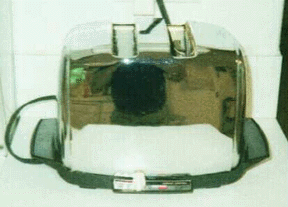
Sunbeam Model T-20 Automatic Toaster
We found this for $4 in Manassas
The Toaster has a beautiful chrome body with incised deco design and bakelite base. It's automatic beyond belief! No levers to push -- no popping or banging. Just drop in the bread and the Sunbeam turns on the current and lowers the bread silently. When perfectly toasted, the current turns off and the toast comes up silently.
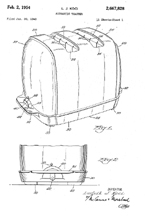
T-20 Design Patent No. 2,667,828
Click to Enlarge
Click here if you want to learn how to get Free Patent Drawings
With "Radiant Control", the toasting is always the same no matter what kind of bread you use. The heat radiated from the surface of the bread activates the exclusive thermostat. That's why you always get the same uniform golden toast you want whether the slices or moist or dry, cold or warm, thick or thin.
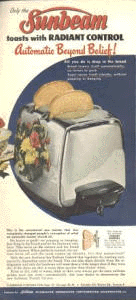
Above, is an ad for the T-20 which appeared in the early 1950s.
These were very popular as wedding gifts when it debuted in 1949. Slots are a little wider than usual. Made in United States America, Sunbeam Corporation, Chicago, U.S.A. Toronto, Canada., 110-120 Volts, 1275 Watts
General Electric Models T77 and T31
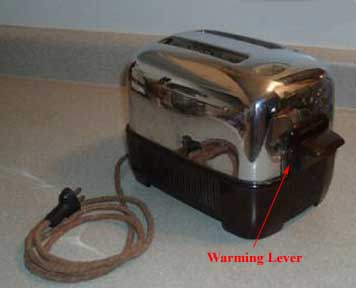

General Electric Toaster Catalog No. 149T77
Although the general design for the T77 and the T31 was patented by Gordon W. Florian in August of 1942, due to World War II and government restrictions on the production of consumer goods, these toasters are most associated with the immediate postwar period, 1946-1949.
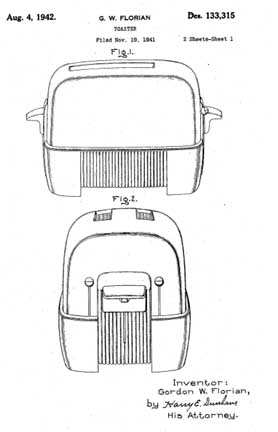
G.W. Florian's Design patent for the GE T77 and T31, D-133,315
Click here if you want to learn how to get Free Patent Drawings
The "T77" (in brown Bakelite) and its close cousin the "T31" (in white Catalin) were sold by General Electric. They incorporate the vast bulk of knowledge about popup toasters that had been accumulated to date. They offer separate controls for lowering and keeping toast warm, but this feature was already on the T-9, so GE was not breaking any new ground.

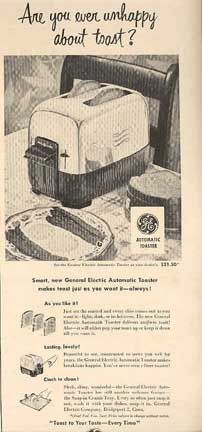
Aliterative Art Advising Acquisition
Note the very distinctive "Wheat and Arrow" design on the T-77 (left)
and the "Ocean Wave Squiggles" on the T-31 (right)
Back in the Fifth Grade, Miss Boyd indoctrinated us in the Rule Against Aliteration. The GE copywriters would have spent some serious time in detention since their slogan for the period was "Toast To Your Taste - Every Time". These are very well-made toasters and should last a lifetime. They were about $19.00 in 1947, which would be roughly $380 in 2005 dollars; hence, they SHOULD last forever! (As an aside, Miss Boyd was quite the hot number -- and she drove a Nash Metropolitan. I don't think that anybody minded detention that much...)
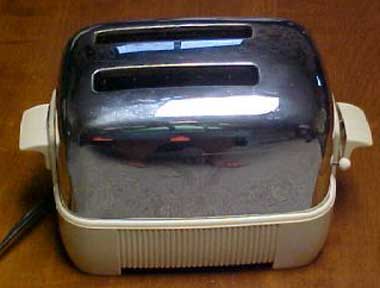
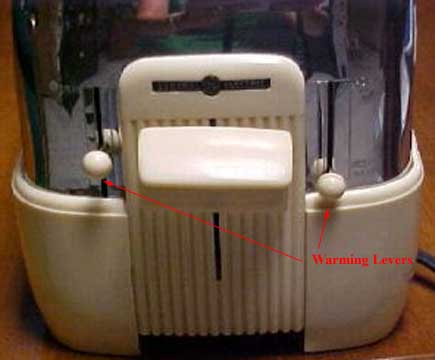
General Electric Toaster Catalog No. 179T31
The T77 and T31 use a vast spectrum of toaster technology. For example, they use the Schlemm process for contolling the two toast lots independently of one another with both warming and toasting circuits.
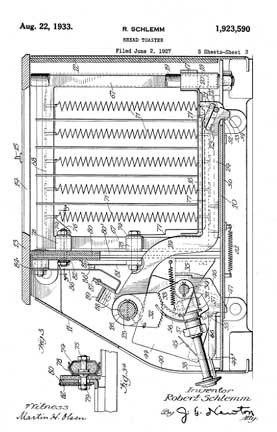
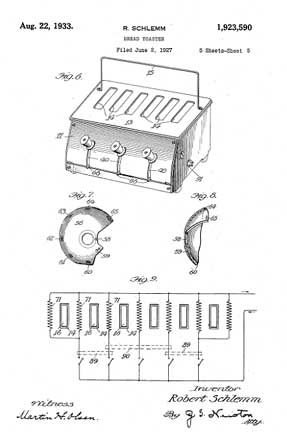
Robert Schlemm Patent 1,923,590 August 22, 1933
Click here if you want to learn how to get Free Patent Drawings
Both toasters use an amalgam of all the best techniques for toast movement and automatic control.
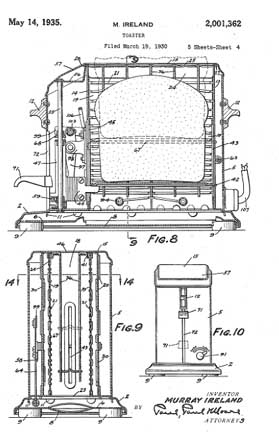
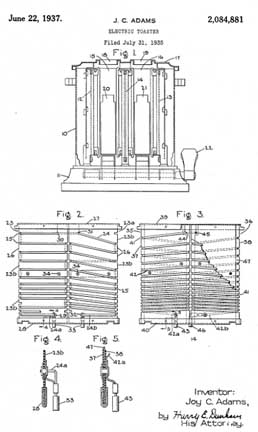
Ireland (May 14, 1935)and Adams (June 22, 1937) Popup Controllers
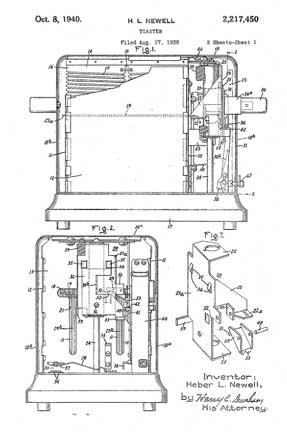
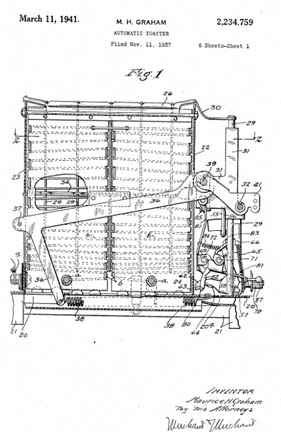
Newell (October 8, 1940) and Graham (March 11, 1941)Popup Controllers
Click here if you want to learn how to get Free Patent Drawings
We must note that the ads for both GE Toasters make much ado about the new and unique crumb tray designed by Harry W. Uhlrig and patented on January 28, 1941. Mr. Uhlrig and Ms Adams are the only inventors associated with General Electric who contributed a patent to these toasters. All of the other inventors worked for McGraw-Edison, GE's big competitor.
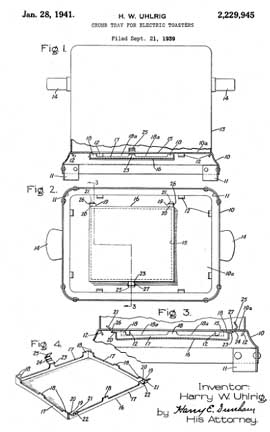
Mr. Uhlrig's Patented Crumb Tray Patent 2,229,945
Click here if you want to learn how to get Free Patent Drawings
Now you know who invented the crumb tray...
Another Truman Toaster
On December 21, 2002, Connie Lausten and David Horne were married in Minneapolis. Connie owns a house in Frederick which she will be selling. She invited the whole vintage group over for a "Last Hurrah" and we, in turn, did a little celebrating of her marriage. Yes, I gave them a General Electric Toaster. BUT, this is not an ORDINARY toaster -- it is JUST LIKE the one in the Harry Truman Museum back in Missouri. This dates to the mid 1950s and probably was the replacement for the 1B5 shown above.
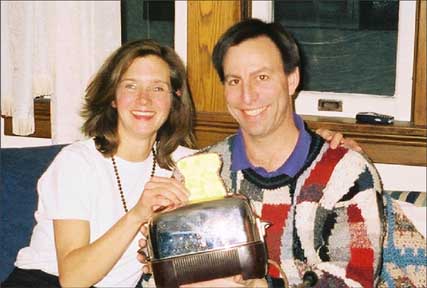
Connie, David, and their Truman-esque Toaster
Toaster Photos From Our Readers
Pam's Fiesta Toaster
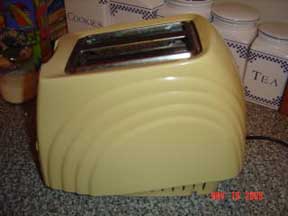
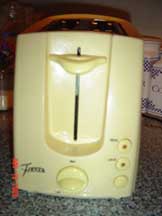
The Fiesta Toaster
This is a very rare toaster enclosed in a beautiful Fiesta china case I want to thank my reader Pam very much for sending us these photos.
Doug's Toaster Collection
We recently heard from Doug, wh wrote:"... I just came across your page and thought I would send you a couple of pictures of my collection of toasters and electric irons. ... I have been collecting for about 20 years and love industrial design in electric appliances. I started with a Toastmaster 1A1 and then found a Toast-O-Later, model J, in a thrift store. That's when Mr. Toad's Wild ride began ..."
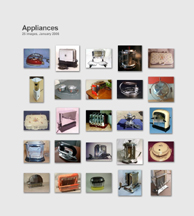
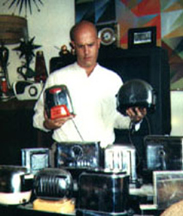
Doug's Collection of Toasters
Thanks a lot for passing this along, Doug.
We want to thank our reader Neil Gould of Hong Kong who writes: "... thought you might like to know that this is the first Toast rack integrated into the toaster. I patented it 5 years ago..."

Here is Neil's Toaster-With-Toast-Rack
Remember, Toasters are for BREAD!. Read about the Flaming Pop Tart Experiment before you put any foreign substances into your beautiful T-9!!!
Here's a fellow who managed to put his entire computer inside a GE Toaster; The CD drawer comes out of the Toast slot...

Join Us on Facebook
Conter for the Entire Site, Not Just this Page
Home | About Lindy | 1940s Collectibles | Upcoming Events | Vintage Clothing
The Guide - Establishments - Travel - Accessories
Music | Links | Photo Gallery | Extras | Contact